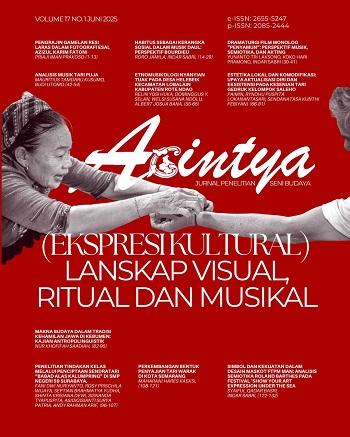LOCAL AESTHETICS AND COMMODIFICATION: EFFORTS TO SELF-ACTUALIZE AND EXISTENCE IN THE GEDRUK DANCE ART OF THE SALEHO GROUP
DOI:
https://doi.org/10.33153/acy.v17i1.7554Keywords:
Folk performance, Local aesthetics, Gayeng, Gedruk, CommodificationAbstract
The development of folk arts has generated diverse modes of performance and increasing complexity. This article examines the dynamics of aesthetics and commodification in tari Gedruk, a folk dance performed by the Saleho group in Boyolali, Central Java. Employing an ethnographic approach, the study explores how this community-based art group integrates local aesthetic values—particularly the concept of gayeng, which emphasizes festivity, spontaneity, and emotional engagement—with commercial strategies as a means of self-actualization and sustaining cultural presence. Gayeng serves as a primary aesthetic parameter, replacing classical standards and reflecting the ways in which aesthetics are experienced and interpreted by local audiences. What kind of aesthetics emerge in such a context? And how do they function within the logic of popular performance? In this framework, tari Gedruk becomes not only a form of cultural expression but also a commodified creative product that aligns with contemporary entertainment demands while preserving its indigenous values. Using the Saleho group as a case study, this article argues that local aesthetics and commodification are not necessarily oppositional, but can instead coexist and inform each other within the evolving landscape of folk performance. Ultimately, commodification here is not solely about generating material profit, but also a strategic response to ensure the continuity and vitality of the art itself. This reflects how traditional arts survive outside palace walls and institutional cultural systems.
Downloads
References
Caturwati, E., & Ramlan, L. (2007). Gugum Gumbira Dari ChaCha Ke Jaipongan. Sunan Ambu Press.
Landler, M. (2007, June 2). Bush’s Greenhouse Gas Plan Throws Europe Off Guard. New York Times, p. A7
Locher, M. A., & Watts, R. J. (2005). Politeness theory and relational work. Journal of Politeness Research, 1(1), 9-33. doi: 10.1515/jplr.2005.1.1.9
Barker, C. (2003). Cultural Studies: Theory and Practice (2nd ed.). London: SAGE Publications Ltd.
Bouvier, H. (2002, August). Lèbur: Seni Musik dan Pertunjukan dalam Masyarakat Madura . Retrieved May 31, 2020, from Yayasan Obor Indonesia website: https://books.google.co.id/books id=bJb7VuY6z2EC&pg=PA413&dq=lebur&hl=id&sa=X&ved=0ahUKEwi-hsyiq97pAhWH83MBHVMKAwQQ6AEIKDAA#v=onepage&q=lebur&f=false
Dani Yanuar, & Purwanto, S. (2025). Musical Transliteration of Tepak Kendang on Fighter Gestures in Kendang Penca. Acintya Jurnal Penelitian Seni Budaya, 16(2), 126–142. https://doi.org/10.33153/acy.v16i2.6756
Fairclough, N. (1992). Discourse and Social Change (1st ed.). https://doi.org/10.1017/CBO9781107415324.004
Fatima, S. P., Wrahatnala, B., & Manggala, B. A. (2023). Strategi Mempertahankan Popularitas Melalui Kegiatan Promosi Media Digital (Studi Kasus Pada Produksi Musik Hendra Kumbara). Acintya Jurnal Penelitian Seni Budaya, 15(1), 58–69. https://doi.org/10.33153/acy.v15i1.5061
Fleischer, R. (2017). If the song has no price, is it still a commodity? Rethinking the commodification of digital music. Culture Unbound, 9(2), 146–162. https://doi.org/10.3384/cu.2000.1525.1792146
Hadi, Y. S. (2007). Kajian Tari: Teks dan Konteks (I). Yogyakarta: Pustaka Book Publisher.
Humardani, G. S. D. (1991). Gendon Humardani Pemikiran dan Kritik (Rustopo, Ed.). Surakarta: STSI-Press Surakarta.
Kiswanto, & Sunarto, B. (2019). Gedrukan, regeng, dan pemicu semangat gerak: makna pemakaian kelinthing dalam pertunjukan topeng ireng. Jurnal Kajian Seni, 06(1), 1–15. https://doi.org/10.22146/jksks.47755
Morphy, H. (2006). From Dull to Brilliant The Aesthetics of Spiritual Power among the Yolngu. In H. Morphy & M. Parkins (Eds.), The Anthropology og Art (1st ed., pp. 302–320). Malden, Oxford, Victoria: Blackwell Publishing Ltd.
Murtono, T., & Wahyudi, D. B. (2025). Cultural Advancement Strategies in Indonesia: a Literature Review. Acintya Jurnal Penelitian Seni Budaya, 16(2), 143–159. https://doi.org/10.33153/acy.v16i2.6177
Niziolek, K. (2018). Art as a Means to Produce Social Benefits and Social Innovations. In V. D. Alexander, S. Hayrynen, S. Hagg, & E. Savanen (Eds.), Art and the Challenge of Markets Volume 2: From Commodification of Art to Artistic Critiques of Capitalism (Vol. 2, pp. 117–143). Cham: Palgrave Macmillan UK.
Puspitasari, L. P. (2015). Pembaruan Tari Rampak Buta oleh Kelompok Krincing Manis. Institut Seni Indonesia Yogyakarta.
Raditya, M. H. B. (2013). Dangdut Koplo : Selera Lokal Menjadi Selera Nasional. Jurnal Seni Musik, 2(2), 1–6.
Rahayu, S. (2018). Estetika Wangsalan dalam Lagu Sindhenan Karawitan Jawa. Gelar, 16. No. 1(Juli), 42–49.
Setyobudi, I. (2017). Budaya Perlawanan di Ranah Seni Indonesia : Produksi-Diri Masyarakat , Habitus , Komodifikasi. Habitus: Jurnal Pendidikan, Sosiologi, Dan Antropolog, I(01), 102–116.
Shils, E. A. (2002). Tradition (2.0; Martext, Ed.). Chicago: The University of Chicago Press.
Simatupang, G. R. L. L. (2010). Perspektif Antropologi dalam Seni dan Estetika. Acintya, 2 No. 1(Juni), 1–6.
Simatupang, G. R. L. L. (2013). Pergelaran: Sebuah Mozaik Penelitian seni Budaya. Yogyakarta: Jalasutra.
Sugiharto, B. (2018). Untuk Apa Seni? In B. Sugiharto (Ed.), Untuk Apa Seni (IV). Bandung: Pustaka Matahari.
Widaryanto, F. X. (2018). Tari dan Berbagai Dimensinya. In B. Sunarto (Ed.), Untuk Apa Seni? (IV, pp. 275–301). https://doi.org/978-602-98762-3-9
Widyastutieningrum, S. R. (1997). Pendidikan Tari di Lembaga Formal (Tinjauan Mengenai Pembentukan Penari). Wiled, 2(Maret), 79–99
Downloads
Published
How to Cite
Issue
Section
License
Copyright (c) 2025 Paimin, Ryndhu Puspita Lokanantasari, Sendanatasa Kunthi Febiyani

This work is licensed under a Creative Commons Attribution 4.0 International License.
Author continues to retain the copyright if the article is published in this journal. The publisher will only need publishing rights




